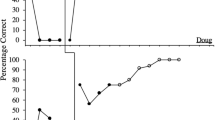Abstract
As puppets are found in most every playroom, their relevance to play therapy is often taken for granted. This paper reviews the therapeutic value of puppets, detailing the psychological functions they can serve. Clinical technique—how to choose and use puppets—is addressed in both theoretical and practical terms.
Similar content being viewed by others
References
Abbot, K. (1990). The use of play in the psychological preparation of preschool children undergoing cardiac surgery.Issues in Comprehensive Pediatric Nursing, 13, 265–277.
Bromfield, R. (1989). Psychodynamic play therapy with a high-functioning autistic boy.Psychoanalytic Psychology, 6, 439–454.
Bromfield, R. (1993).Playing for real: A child therapist explores the world of play therapy and the inner worlds of children. New York: Penguin USA.
Egge, D. (1987). Puppets and adolescents: A group guidance workshop approach.Elementary School Guidance Counseling, 21, 183–192.
Ekstein, R. (1965). Puppet play of a psychotic adolescent girl in the psychotherapeutic process.Psychoanalytic Study of the Child, 20, 441–480.
Gill, E. (1994).Play in family therapy. New York: Guilford.
Ginott, H. (1959). The theory and practice of ‘therapeutic intervention’ in child treatment.Journal of Clinical and Consulting Psychology, 23, 160–166.
Hawkey, L. (1951). The use of puppets in child psychotherapy.British Journal of Medical Psychology, 24, 206–214.
Irwin, E. (1983). The diagnostic and therapeutic use of pretend play. InHandbook of Play Therapy. New York: Wiley.
Irwin, E. & Shapiro, M. (1975). Puppetry as a diagnostic and therapeutic technique.Psychiatry and Art, 4, 86–94.
Kohut, H. (1977).The restoration of the self. New York: International Universities Press.
Jacobson, E. (1954). The self and object world.Psychoanalytic Study of the Child, 9, 75–127.
Linn, S. (1986). Puppet therapy with pediatric bone marrow transplant patients.Journal of Pediatric Psychology, 11, 37–46.
Rambert, M. (1949).Children in conflict. New York: International Universities Press.
Shuttleworth, R. (1986). Alternate methods of communicating with children in family therapy.Maladjustment and Therapeutic Education, 4, 55–66.
Webb, N. (1991). Play therapy crisis intervention with children. InPlay Therapy with Children in Crisis. New York: Guilford.
Winnicott, D. (1945). Primitive emotional development. InPediatrics to Pycho-Analysis. London: Hogarth.
Winnicott, D. (1951). Transitional objects and transitional phenomena. InThrough Pediatrics to Psycho-Analysis. London: Hogarth.
Author information
Authors and Affiliations
Rights and permissions
About this article
Cite this article
Bromfield, R. The use of puppets in play therapy. Child Adolesc Soc Work J 12, 435–444 (1994). https://doi.org/10.1007/BF01875812
Issue Date:
DOI: https://doi.org/10.1007/BF01875812




